I extracted data from the scatterplot for analysis and found that a polynomial + sine did not seem to be an optimal model, because lower order polynomials were not following the shape of the data very well and higher order polynomials were exhibiting Runge's phenomenon of high curvature at the data extremes. I performed an equation search to find what the high-frequency sine wave might be imposed upon, and a good candidate seemed to be the Extreme Value peak equation "a * exp(-1.0 * exp(-1.0 * ((x-b)/c))-((x-b)/c) + 1.0) + offset" as shown below.
Here is a graphical Python curve fitter for this equation, at the top of the file I load the data I had extracted so you would need to replace this with the actual data. This fitter uses scipy's differential_evolution genetic algorithm module to estimate initial parameter values for the non-linear fitter, which uses the Latin Hypercube algorithm to ensure a thorough search of parameter space and requires bounds within which to search. Here those bounds are taken from the data maximum and minimum values.
Subtracting the model predictions from this fitted curve should leave you with only the sine component to be modeled. I noted that there seems to be an additional narrow, low-amplitude peak at approximately x = 275.

import numpy, scipy, matplotlib
import matplotlib.pyplot as plt
from scipy.optimize import curve_fit
from scipy.optimize import differential_evolution
import warnings
##########################################################
# load data section
f = open('/home/zunzun/temp/temp.dat')
textData = f.read()
f.close()
xData = []
yData = []
for line in textData.split('\n'):
if line: # ignore blank lines
spl = line.split()
xData.append(float(spl[0]))
yData.append(float(spl[1]))
xData = numpy.array(xData)
yData = numpy.array(yData)
##########################################################
# model to be fitted
def func(x, a, b, c, offset): # Extreme Valye Peak equation from zunzun.com
return a * numpy.exp(-1.0 * numpy.exp(-1.0 * ((x-b)/c))-((x-b)/c) + 1.0) + offset
##########################################################
# fitting section
# function for genetic algorithm to minimize (sum of squared error)
def sumOfSquaredError(parameterTuple):
warnings.filterwarnings("ignore") # do not print warnings by genetic algorithm
val = func(xData, *parameterTuple)
return numpy.sum((yData - val) ** 2.0)
def generate_Initial_Parameters():
# min and max used for bounds
maxX = max(xData)
minX = min(xData)
maxY = max(yData)
minY = min(yData)
minData = min(minX, minY)
maxData = max(maxX, maxY)
parameterBounds = []
parameterBounds.append([minData, maxData]) # search bounds for a
parameterBounds.append([minData, maxData]) # search bounds for b
parameterBounds.append([minData, maxData]) # search bounds for c
parameterBounds.append([minY, maxY]) # search bounds for offset
# "seed" the numpy random number generator for repeatable results
result = differential_evolution(sumOfSquaredError, parameterBounds, seed=3)
return result.x
# by default, differential_evolution completes by calling curve_fit() using parameter bounds
geneticParameters = generate_Initial_Parameters()
# now call curve_fit without passing bounds from the genetic algorithm,
# just in case the best fit parameters are aoutside those bounds
fittedParameters, pcov = curve_fit(func, xData, yData, geneticParameters)
print('Fitted parameters:', fittedParameters)
print()
modelPredictions = func(xData, *fittedParameters)
absError = modelPredictions - yData
SE = numpy.square(absError) # squared errors
MSE = numpy.mean(SE) # mean squared errors
RMSE = numpy.sqrt(MSE) # Root Mean Squared Error, RMSE
Rsquared = 1.0 - (numpy.var(absError) / numpy.var(yData))
print()
print('RMSE:', RMSE)
print('R-squared:', Rsquared)
print()
##########################################################
# graphics output section
def ModelAndScatterPlot(graphWidth, graphHeight):
f = plt.figure(figsize=(graphWidth/100.0, graphHeight/100.0), dpi=100)
axes = f.add_subplot(111)
# first the raw data as a scatter plot
axes.plot(xData, yData, 'D')
# create data for the fitted equation plot
xModel = numpy.linspace(min(xData), max(xData))
yModel = func(xModel, *fittedParameters)
# now the model as a line plot
axes.plot(xModel, yModel)
axes.set_xlabel('X Data') # X axis data label
axes.set_ylabel('Y Data') # Y axis data label
plt.show()
plt.close('all') # clean up after using pyplot
graphWidth = 800
graphHeight = 600
ModelAndScatterPlot(graphWidth, graphHeight)
UPDATE -------
If the high-frequency sine component is constant (which I do not know) then modeling a small portion of the data with only a few cycles will be sufficient to determine the equation and initial parameter estimates for fitting the sine wave portion of the model. Here I have done this with the following result:

from the following equation:
amplitude = -1.0362957093184177E+00
center = 3.6632754608370377E+01
width = 5.0813421718648293E+00
Offset = 5.1940843481496088E+00
pi = 3.14159265358979323846 # constant not fitted
y = amplitude * sin(pi * (x - center) / width) + Offset
Combining these two models using the actual data, rather than my scatterplot-extracted data, should be close to what you need.

